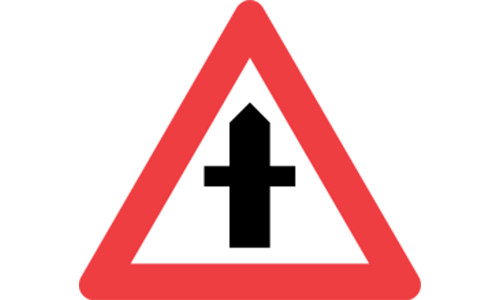
This warning sign, with its depiction of a main road and a smaller intersecting road, indicates a dangerous junction where the road you are on does not have priority over the intersecting road.
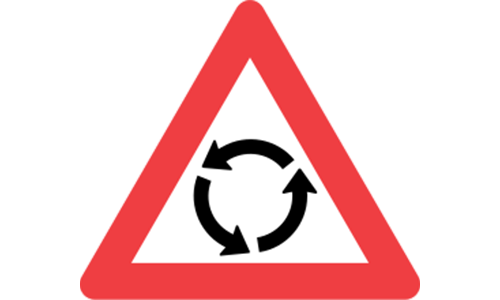
This triangular warning sign with circular arrows is universally recognized. It specifically warns drivers of an approaching roundabout.
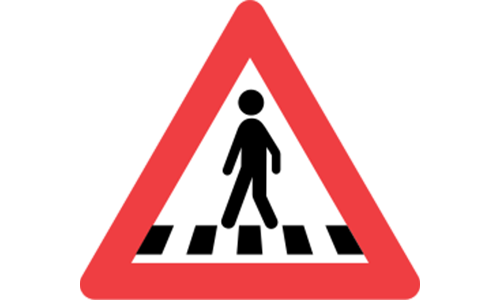
This triangular warning sign with a pedestrian figure indicates that there is a marked pedestrian crossing ahead, and drivers should be prepared to stop.

This triangular warning sign, featuring two vertical arrows pointing in opposite directions, informs drivers that the road ahead supports two-way traffic, often used to indicate the end of a one-way street or a change in traffic conditions.

This triangular sign, depicting a vertical traffic light, indicates that traffic signals are present ahead on the road. Drivers should prepare to adjust their speed and potentially stop, depending on the signals indication.
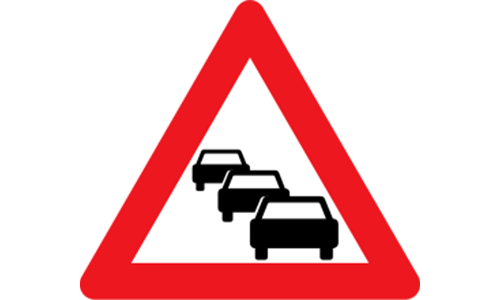
This sign warns drivers of the possibility of encountering a traffic queue or congestion further along the road. It advises drivers to slow down and be prepared for reduced speeds or stops, helping to prevent rear-end collisions.
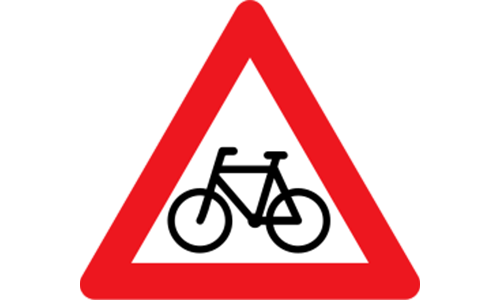
This sign warns drivers of the potential presence of cyclists on or near the road. Drivers should be particularly alert for cyclists crossing the road or cycling alongside traffic. Always give cyclists ample space and be prepared for unexpected movements.

This sign indicates that children are likely to be in or near the road. This warning is often placed near schools, parks, or residential areas where children might play or cross unexpectedly. Drivers must reduce speed and exercise extreme caution.

Featuring a horse and rider, this sign warns drivers of the potential presence of equestrians crossing or moving along the road. Drivers should reduce speed, approach quietly, and give horses and riders a wide berth. Sudden noises or movements can startle horses.
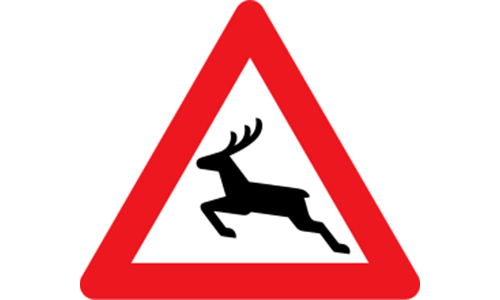
This triangular sign, showing a deer, warns drivers of areas where wild animals frequently cross the road. It indicates a higher risk of animals suddenly appearing on the carriageway, especially at dawn, dusk, or night. Drivers should slow down and be prepared to stop.

It means cattle or other large livestock may be present on or near the road. This is common in rural areas or near farms, advising drivers to reduce speed and be prepared for animals blocking the path. Exercise caution and patience if animals are in the road.
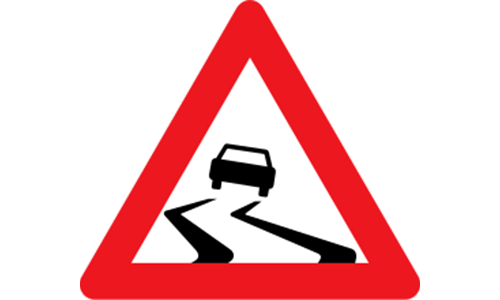
This sign warns drivers of a road surface that is prone to becoming slippery, especially due to rain, ice, or loose material. Drivers should reduce speed, avoid sudden braking or steering, and increase their following distance. Adjusting driving style to anticipate reduced grip is essential.
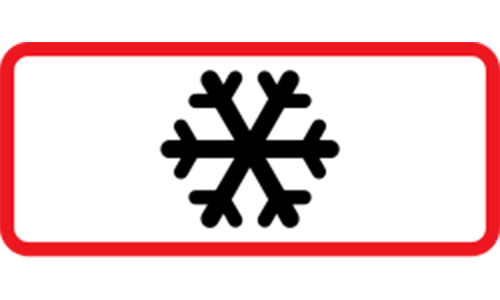
This sign warns about a specific road condition where the surface is prone to icing, even when other areas are clear. Drivers should exercise extreme caution, reduce speed significantly, and be prepared for very limited traction. Avoiding sudden maneuvers is crucial in such conditions.
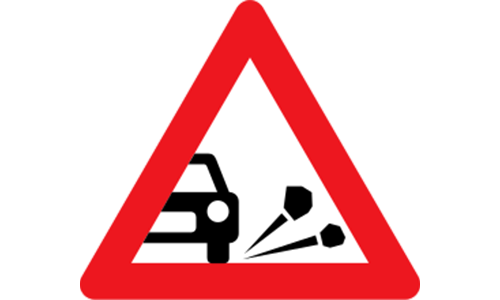
This sign warns drivers of loose gravel or chippings on the road surface. These loose stones can reduce tire grip, cause skidding, or be thrown up by tires, potentially damaging other vehicles. Drivers should reduce speed and proceed with caution.

This sign warns drivers of areas where rocks or debris may fall onto the road from cliffs or steep hillsides. It signifies a risk of rockfall, advising drivers to be aware of potential hazards on the carriageway. Exercise extreme caution, especially during or after adverse weather.

This sign warns drivers that the roadside shoulder may be unstable, uneven, or too narrow to safely drive or stop on. Drivers should avoid pulling over onto such shoulders unless absolutely necessary, as it could cause loss of control or vehicle damage.
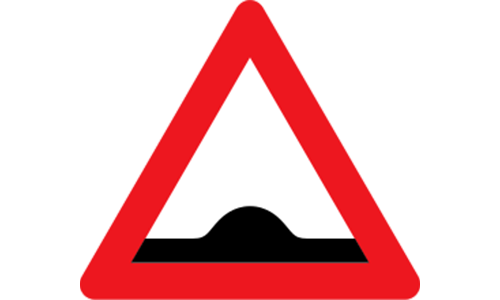
This sign alerts drivers to the presence of a speed bump or hump ahead. These are designed to force vehicles to reduce speed, so drivers should slow down to avoid discomfort or damage to their vehicle. Be especially mindful of cyclists and motorcyclists.

This sign warns drivers that the road surface ahead may have irregularities, potholes, or rough patches. Such conditions could affect vehicle stability and passenger comfort. Drivers should reduce speed to maintain control and avoid damage to their vehicle.
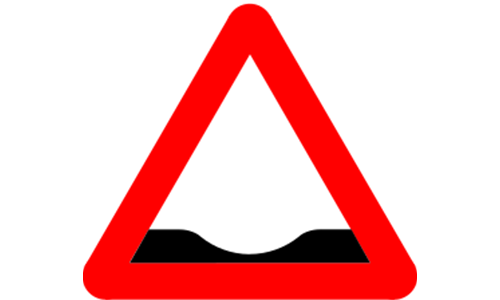
This sign warns drivers of a dip or sudden depression in the road ahead. Such dips can obscure visibility of oncoming traffic or create a loss of control if taken at high speed. Drivers should slow down and be prepared for the change in road level.
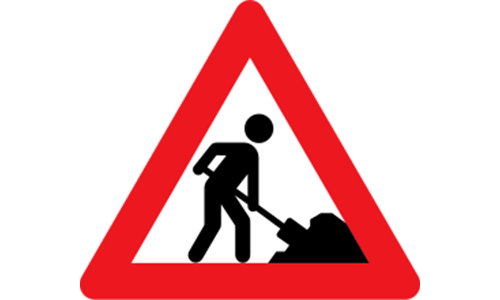
This sign signifies that roadworks or construction is taking place ahead. There may be temporary lane closures, altered traffic patterns, or workers on the road. Drivers should reduce speed and follow any temporary signage carefully for their safety and the safety of workers.
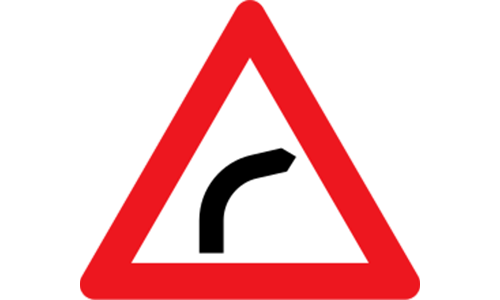
This warning sign indicates that there is a curve or bend to the right ahead. Drivers should reduce their speed before entering the curve to safely navigate it and maintain control of their vehicle.

This warning sign indicates an approaching curve to the left. The primary action for drivers is to reduce speed before entering the curve to maintain vehicle control, ensure safety, and prevent veering off the road or into oncoming traffic.
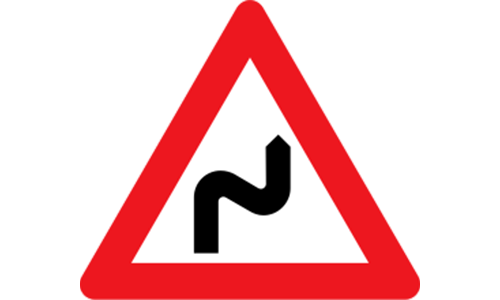
This warning sign indicates that there is a winding road ahead, featuring a series of curves, with the very first bend being to the right. Drivers should significantly reduce their speed and be prepared for continuous changes in road direction and potential reduced visibility.
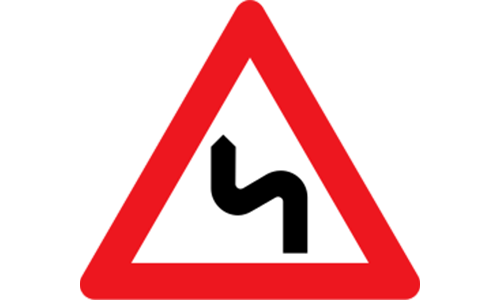
This warning sign indicates that there is a winding road ahead, featuring a series of curves, with the very first bend being to the left. Drivers should significantly reduce their speed and be prepared for continuous changes in road direction and potential reduced visibility.

This sign provides a recommended speed, often used to advise drivers on a safe speed for an upcoming road feature, such as a sharp curve. While not a mandatory speed limit, drivers are advised to adhere to this speed for safety and optimal control, especially in challenging road sections.

This warning sign indicates that the road ahead narrows from both sides. Drivers should be prepared for reduced road width, potentially requiring them to adjust their position, slow down, and be cautious of oncoming or adjacent traffic.
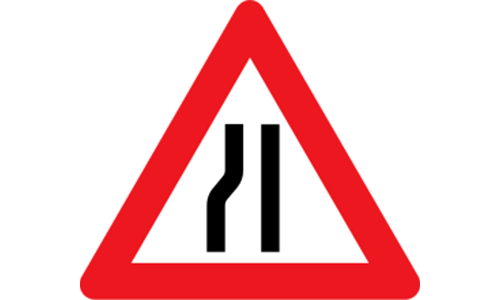
This warning sign indicates that the road ahead narrows significantly on the left side. Drivers should be prepared for reduced road width on that side, adjust their position, slow down, and be cautious, especially of vehicles in the affected lane.
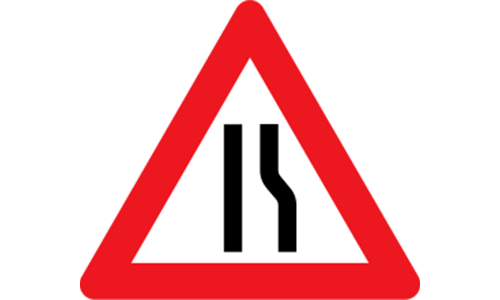
This warning sign indicates that the road ahead narrows significantly on the right side. Drivers should be prepared for reduced road width on that side, adjust their position, slow down, and be cautious, especially of vehicles in the affected lane.
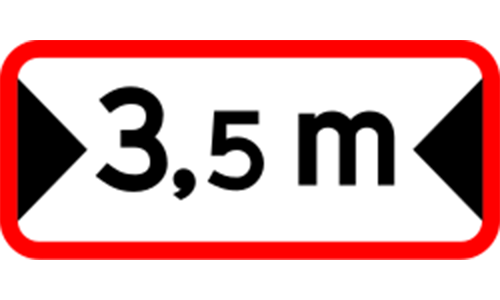
This warning sign indicates that there is a width limit ahead, meaning vehicles wider than 3.5 meters are not permitted or may have difficulty passing. Drivers of wide vehicles should find an alternative route or proceed with extreme caution if their vehicle is at or near the limit.

This warning sign indicates that a tunnel is approaching. Drivers should be prepared for changes in light levels, reduced visibility, potential ventilation issues, and should turn on their headlights if not already on when entering the tunnel.
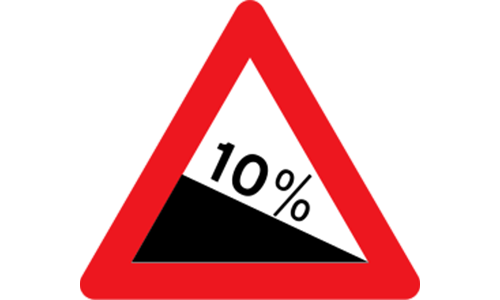
This warning sign indicates a steep downward gradient (a downhill slope) ahead, with the percentage (e.g., 10%) indicating the severity of the slope. Drivers should select a lower gear to use engine braking, control their speed, and be prepared for increased braking distances.
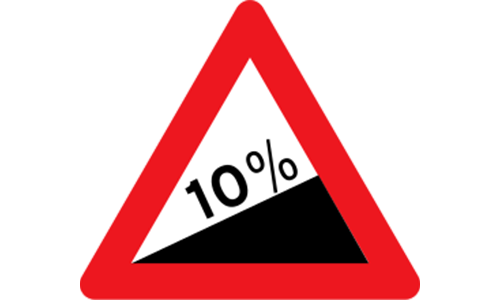
This warning sign indicates a steep upward gradient (an uphill slope) ahead, with the percentage (e.g., 10%) indicating the severity of the climb. Drivers may need to select a lower gear to maintain speed and power, especially in heavy vehicles or with a heavy load.
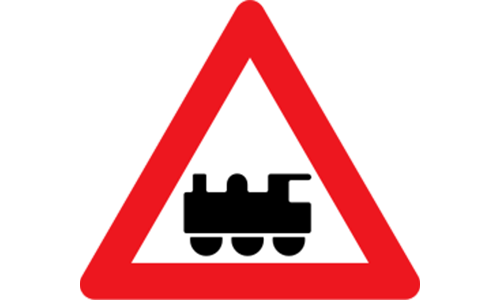
This warning sign indicates an upcoming railway level crossing that does not have automatic gates or barriers. Drivers must exercise extreme caution, look and listen for trains, and be prepared to stop well before the tracks if a train is approaching.

This sign indicates an upcoming railway level crossing that does have automatic gates or barriers. While gates are present, drivers must still be prepared to stop if the barriers are down or a train is approaching, and never attempt to cross when the signals are activated.

This specific sign (often called a St. Andrews Cross) is placed at the actual location of a railway crossing and indicates that it is a single-track level crossing. Drivers must stop, look, and listen for trains before proceeding safely across the tracks.

This warning sign indicates that you are approaching a level crossing with more than one railway track. Drivers must exercise extreme caution, be prepared to stop, and ensure no trains are approaching on any track before crossing safely.
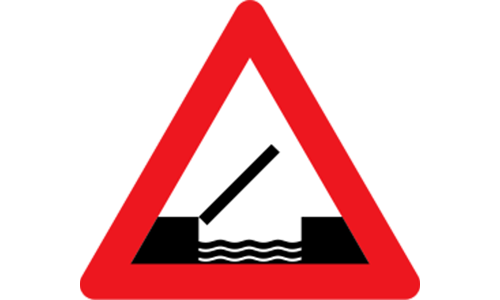
This warning sign indicates that you are approaching an opening bridge (also known as a swing bridge or bascule bridge). Drivers should be prepared to stop if the bridge is open or is being opened to allow water traffic to pass.

This warning sign indicates that the road runs alongside or ends abruptly at a body of water, such as a quayside, river bank, or canal. Drivers should exercise extreme caution to avoid accidentally driving into the water.
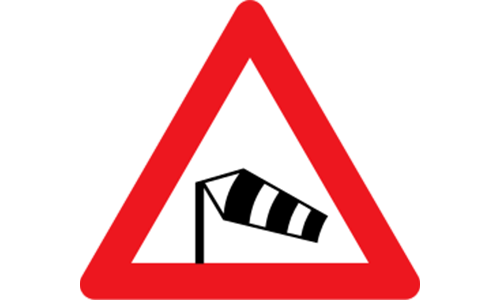
This warning sign indicates an area where strong side winds or crosswinds are prevalent. Drivers, especially those in high-sided vehicles, motorcyclists, or those towing trailers, should grip the steering wheel firmly and be prepared for sudden gusts that could affect vehicle stability.

This warning sign indicates an area where low-flying aircraft or sudden aircraft noise may be encountered, often near airports. Drivers should be aware of potential distractions and be prepared for unexpected loud noises.

This warning sign indicates an area where low-flying helicopters or sudden helicopter noise may be encountered. Drivers should be aware of potential distractions and be prepared for unexpected loud noises.

This warning sign is used to indicate a general danger or hazard that is not covered by any other specific warning sign. It often comes with a supplementary plate that specifies the nature of the danger. Drivers should proceed with extreme caution and be alert.
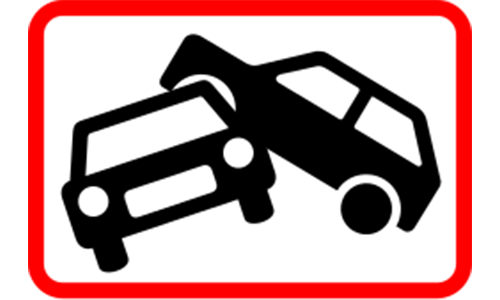
This sign indicates that you are approaching an intersection or junction that has a history of frequent accidents. Drivers should exercise heightened caution, reduce speed, and be extra vigilant for potential hazards with other road users at this location.
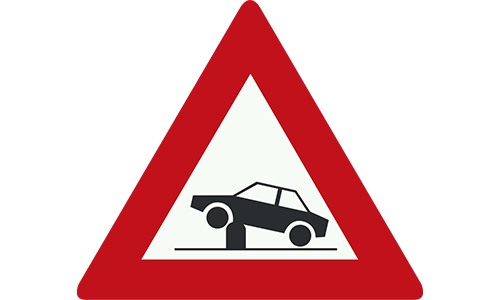
The sign specifically warns drivers about the presence of a retractable bollard in the road. These bollards are used to control access to certain streets or areas and can rise from the ground.
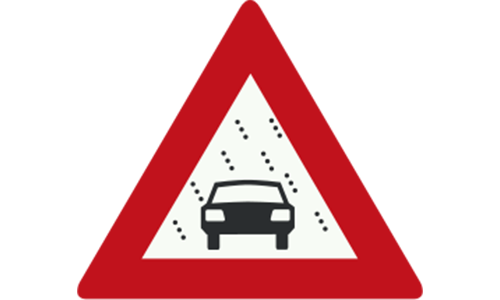
The sign specifically warns drivers that they may experience reduced visibility. This reduction can be caused by snow, rain, or fog.
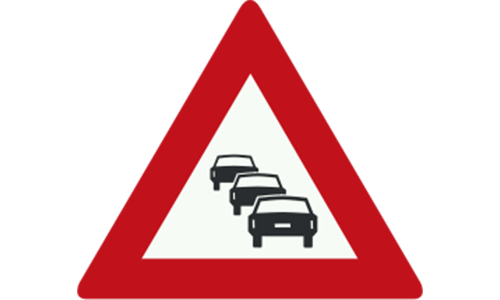
The sign directly warns drivers that they are approaching an area where queues or traffic jams are likely to form. This alerts drivers to be prepared for slowing or stopping traffic.

This sign is a distance marker for a level crossing. A single red diagonal line indicates that the level crossing is very close typically around 50 meters.

This sign is a distance marker for a level crossing. Two red diagonal lines indicate that the level crossing is moderately close typically around 100 meters away.

This sign is a distance marker for a level crossing. Three red diagonal lines indicate that the level crossing is relatively far, typically around 150 to 250 meters away.
 Pass the Exam easily with Premium Practice Tests | Unlock All with 7 Days Plan
Pass the Exam easily with Premium Practice Tests | Unlock All with 7 Days Plan  Offer Ends in
Offer Ends in 


